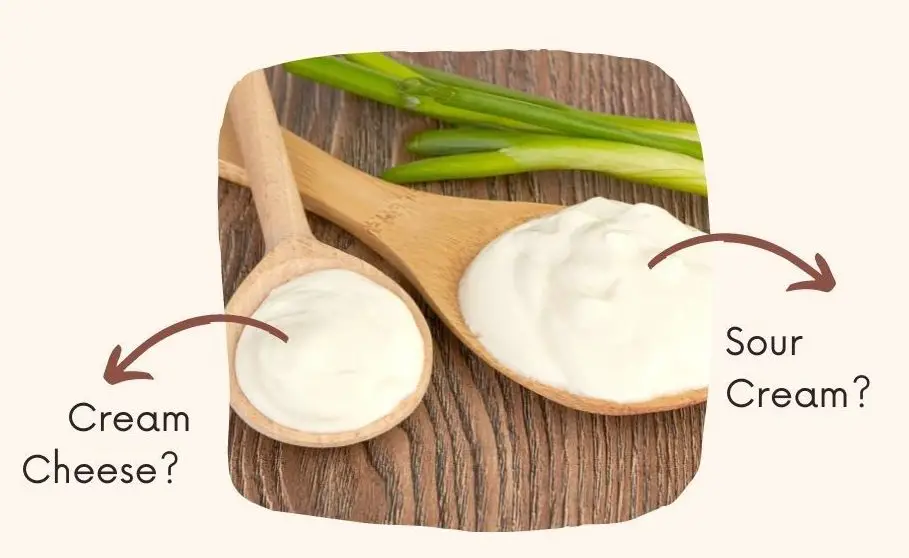Last Updated on April 12, 2023 by Aaron
When it comes to cooking, two of the most commonly used ingredients are sour cream and cream cheese. These two ingredients are often used interchangeably in recipes, and while they share some similarities, they are not exactly the same thing.
So, what exactly are the differences between sour cream and cream cheese, and which one is better?
Table of Contents
What is Sour Cream?
Sour cream is a dairy product that is made by fermenting cream with lactic acid bacteria. This fermentation process gives sour cream its characteristic tangy flavor and thick, creamy texture. Sour cream is often used in dips, sauces, and as a topping for baked potatoes and tacos.
What is Cream Cheese?
Cream cheese is a soft, spreadable cheese that is made by blending cream and milk with lactic acid bacteria. Cream cheese is typically less tangy than sour cream and has a smoother texture. It is often used as a spread for bagels and toast, as well as in dips and cheesecake.
Read how it’s made here step by step.

Taste and Texture
One of the biggest differences between sour cream and cream cheese is their taste and texture. Sour cream has a tangier, slightly acidic flavor that is often used to balance out rich or spicy dishes. It also has a thick, creamy texture that can be used to add richness to dips and sauces.
Cream cheese, on the other hand, has a milder, creamier flavor (and slightly sweet) that is often used as a base for sweet or savory dishes. It has a thicker, spreadable texture that is perfect for use as a spread for bagels and toast.
Nutritional Differences
When comparing sour cream and cream cheese, it’s important to consider their nutritional value. They are both high in fat and calories.
However, sour cream is often slightly lower in fat and calories than cream cheese. Here’s a breakdown of the nutritional differences between the two spreads:
Sour Cream source:
- 1 tablespoon of sour cream contains approximately 23 calories
- 1 tablespoon of sour cream contains 2 grams of fat, less than 1 gram of protein and carbohydrates
- Sour cream is lower in sodium and fat.
Cream Cheese source:
- 1 tablespoon of cream cheese contains approximately 51 calories
- 1 tablespoon of cream cheese contains 5 grams of fat, 1 gram of protein, and 1 gram of carbohydrates
- Cream cheese is a better source of protein (3x) and other micronutrients.
The value above is obtained via FoodData Central of USDA. The actual value may vary on the brands and varieties of products (i.e the low-fat versions).
For example, a tub of original Philadelphia cream cheese contains about 22% fat content. In contrast, a tub of Daisy Brand sour cream has about 17% of fat. And that will also affect the nutritional value, taste, and texture.
If you would like to know the best brands of cream cheese out there (ingredients and fat value) read this latest article.

Uses in Cooking
Both sour cream and cream cheese are versatile ingredients that can be used in a variety of dishes.
Sour cream is often used as a topping for dishes like baked potatoes and chili, as well as in dips, dressings, and baked goods. Cream cheese is commonly used as a spread for bagels and toast, as well as in dips, spreads, and desserts like cheesecake.
Here are some of the ways each spread can be used:
Sour Cream:
- As a topping for baked potatoes or tacos
- As a dip for vegetables or chips
- As a base for salad dressings or sauces
- As a substitute for mayonnaise or yogurt in recipes
Cream Cheese:
- As a spread for bagels or toast
- As a base for cheesecake or frosting
- As a filling for stuffed vegetables or chicken breasts
- As a topping for crackers or fruit
If you want to substitute cream cheese for sour cream in a cheesecake recipe, it is best to use a 3-to-4 ratio. For example, if a recipe calls for one cup of sour cream, you can use approximately three-fourths cup of cream cheese mixed with 1-2 tablespoons of milk or buttermilk.
If you are making a sauce or dip, you can use slightly more amount of cream cheese. Start by mixing the softened cream cheese with some of the wet ingredients from the recipe. Then add additional seasoning to taste. Be sure to stir well so that the cream cheese is fully combined to avoid lumps as discussed.
Key Takeaway: Which is Better?
The answer ultimately depends on the intended use. Sour cream and cream cheese are both versatile ingredients that can be used in a variety of dishes.
Although they have similar taste and texture profiles, cream cheese is usually a better complement to bread products. On the other hand, sour cream is a popular option to add a depth of flavor and richness to dishes.
It’s also worth noting that both sour cream and cream cheese can be substituted and used interchangeably. Sour cream can be used as a 1:1 in equal amount substitute for mayonnaise or yogurt in recipes, while cream cheese can be too thick — thin it with 1 part of milk for every 4 parts of cream cheese.
In addition, if you would like to make your cream cheese taste like sour cream, you can add some yogurt, lemon juice, or vinegar. Alternatively, try Creme fraiche, which is a type of French sour cream similar to cream cheese.

